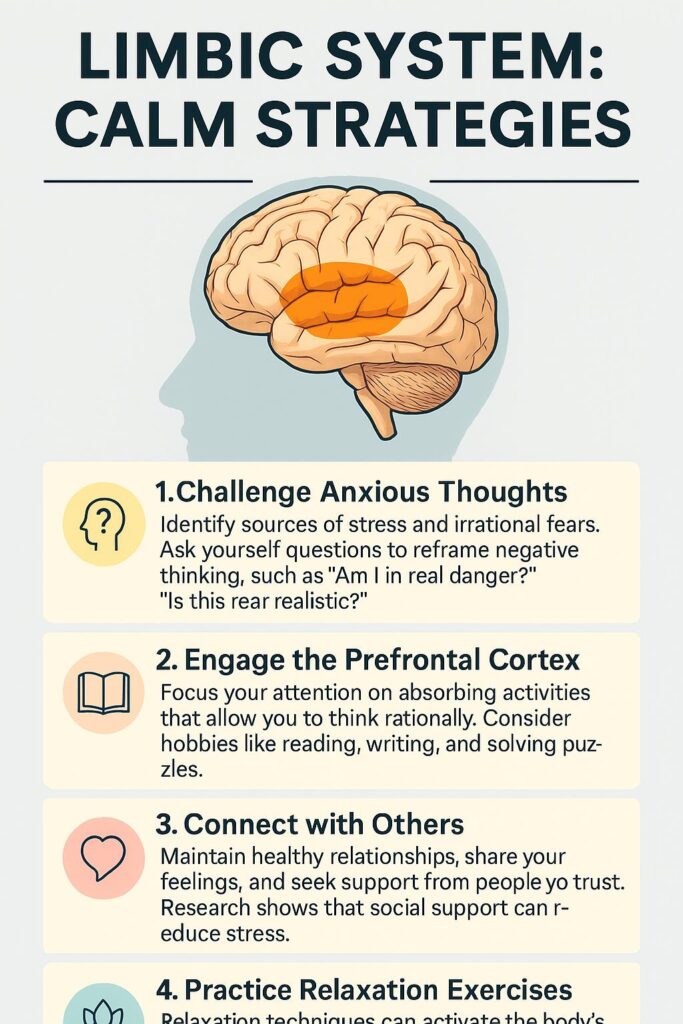Understanding the Limbic System: The Brain’s Emotional Center
By Dr. Douglas Cowan, Psy.D.
Marriage and Family Therapist
Anxiety doesn’t start in your thoughts—it starts in your brain. Specifically, it begins in a deeply wired part of the brain called the limbic system. This collection of ancient brain structures governs our emotional life, especially fear and survival instincts. If you’ve ever wondered why anxiety feels out of your control, or why it hits without warning, it’s because the limbic system can bypass your conscious thinking. But once you understand how it works, you can begin to use that knowledge to heal and regain calm.
What Is the Limbic System?
The limbic system is the brain’s emotional command center. It’s a network of interconnected structures located beneath the cerebral cortex, responsible for processing emotions, forming memories, reacting to threats, and regulating the nervous system. It functions far faster than the thinking part of the brain—the neocortex—because survival doesn’t wait for logic.
- Key structures include:
- – **Amygdala**: Triggers fear and activates the stress response.
- – **Hippocampus**: Stores emotional memories and helps contextualize fear.
- – **Hypothalamus**: Regulates the autonomic nervous system and stress hormones.
- – **Thalamus**: Acts as a relay station for sensory input, helping the brain focus on danger cues.
These structures work together to interpret threats and prepare your body to respond. While this system is crucial for staying alive, an overactive limbic system leads to chronic anxiety, intrusive thoughts, and even panic attacks.
The Amygdala: Your Brain’s Smoke Alarm
The amygdala is a small almond-shaped cluster deep in the temporal lobe. It constantly scans your environment and reacts to any perceived threat—whether real, remembered, or imagined. When the amygdala detects danger, it sends signals to the hypothalamus to activate the body’s fight-or-flight response.
Unfortunately, the amygdala doesn’t always get it right. It can interpret a stressful email or an upcoming deadline the same way it would a lion in the bushes. In trauma survivors, the amygdala becomes hyper-responsive, reacting even to harmless stimuli with intense fear.
The Hippocampus: Memory Meets Emotion
The hippocampus is involved in forming and retrieving long-term memories. It helps the amygdala judge whether a current experience is similar to past dangers. If the hippocampus is damaged or underperforming (as seen in chronic stress or PTSD), the brain loses the ability to put fears in context, leading to a sense of danger even when none exists.
How Chronic Stress Alters the Limbic System
When your brain is exposed to high levels of stress hormones (like cortisol) over long periods, the limbic system changes. The amygdala grows more reactive. The hippocampus can shrink. Neural pathways for fear strengthen, while those for calm and logic weaken.
This creates a feedback loop: stress makes your brain more prone to anxiety, and anxiety causes more stress. Breaking the cycle means retraining the brain—not just with thoughts, but with physical experiences of safety.
How to Calm the Limbic System (Bottom-Up Approaches)
To calm the limbic system, we must speak its language: sensation, rhythm, emotion, and presence. Bottom-up tools work from the body to the brain, soothing the nervous system without needing rational thought.
- Here are effective tools that work directly on the limbic system:
- – **Breathwork**: Techniques like the 4-4-6 pattern or supercharged sigh stimulate the vagus nerve and reduce amygdala activity.
- – **EFT Tapping**: Stimulates cranial nerve points that send calming signals back to the emotional brain.
- – **CES (Cranial Electrotherapy Stimulation)**: Gentle, non-invasive stimulation shown to reduce anxiety by balancing brainwave activity.
- – **Phototherapy Patches (X39, Aeon)**: Support cellular repair, reduce inflammation, and aid neurological regulation.
- – **Guided imagery and prayer**: Bypass logic and tap into emotion, memory, and imagination—directly accessing limbic circuits.
Faith and the Limbic Brain
Spiritual practices like prayer, meditation, and gratitude create a sense of safety and meaning—both of which calm the limbic system. Regular spiritual reflection has been shown to reduce inflammation and increase activation of the prefrontal cortex, promoting resilience.
Top-Down Tools Still Matter
While bottom-up strategies calm the body, top-down approaches help reframe your story. These include cognitive-behavioral therapy (CBT), journaling, thought reframing, and affirmations. These tools work best when the limbic system is not in full fight-or-flight mode—which is why bottom-up work is often needed first.
Daily Rhythms for Limbic System Recovery
- To support your limbic system daily, try this rhythm:
- – Morning: X39 and Aeon patches, gratitude practice, hydration, and breathwork
- – Afternoon: Movement, nature, journaling, or tapping
- – Evening: CES CalmBox session, slow breathing, and prayer or reflection
Final Thoughts
The limbic system is not your enemy—it’s trying to protect you. But when it gets stuck on high alert, it creates suffering. By understanding this system and using both bottom-up and top-down strategies, you can help your brain feel safe again—and from that place of safety, healing and growth are possible.
*This article is for educational purposes only. Please consult a licensed mental health provider for personal diagnosis and treatment planning.*

